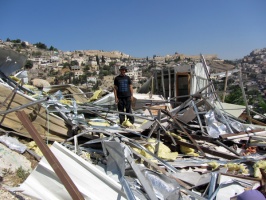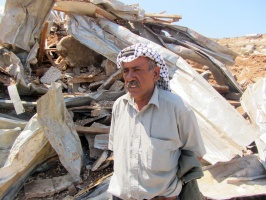- About
- News
-
Advocacy
- Accountability & Litigation
- International Advocacy
- National Advocacy
- Documentation
- FAI Unit
- Al-Haq Publications
- Library


- About
- News
-
Advocacy
- Accountability & Litigation
- International Advocacy
- National Advocacy
- Documentation
- FAI Unit
- Al-Haq Publications
- Library
 During the previous week, Al-Haq documented four cases of demolition of Palestinian homes and other structures throughout the West Bank, including East Jerusalem. On 19 August, Israeli bulldozers demolished structures belonging to the Ka’abneh Palestinian Bedouin community, displacing its 39 members. On 20 August, Al-Haq documented additional demolition operations carried out by the Israeli forces in: Humsa village (Tubas governorate), Jiftlik village (Jericho governorate) and Silwan (East Jerusalem).
During the previous week, Al-Haq documented four cases of demolition of Palestinian homes and other structures throughout the West Bank, including East Jerusalem. On 19 August, Israeli bulldozers demolished structures belonging to the Ka’abneh Palestinian Bedouin community, displacing its 39 members. On 20 August, Al-Haq documented additional demolition operations carried out by the Israeli forces in: Humsa village (Tubas governorate), Jiftlik village (Jericho governorate) and Silwan (East Jerusalem).
The United Nations Office for the Coordination of Humanitarian Affairs (UN OCHA) in the Occupied Palestinian Territory (OPT) stated that during 2013, the number of house demolitions implemented by the Israeli authorities in East Jerusalem has significantly increased. In addition UN OCHA asserted that “[t]he number of people displaced this year in East Jerusalem is now over 200, by far the highest number since 2009”.
Ali Hasan Ka’abneh – Beit Hanina – Jerusalem
On 19 August, at around 4:00 am, approximately 35 Israeli military jeeps arrived at the Ka’abneh Palestinian Bedouin community in Beit Hanina. The Israeli soldiers ordered the 39 members of the community to evacuate their houses. In addition, two police dogs forced the residents’ sheep out from their sheds, causing the herd to escape to a nearby hill.
The residents remained outside their homes until 6:00 am, when two Israeli bulldozers arrived and proceeded to demolish the community’s homes and animal sheds. At 9:00 am, when the demolition operation had ended, an Israeli officer informed Ali that the community members had ten days to evacuate the area and remove the rubble caused by the demolition operation. The Israeli authorities threatened to remove the residents by force and impose a fine of NIS 70,000 (approximately USD 1,930) on each of the four senior members of the community if they refused to comply. The residents managed to gather their sheep and, after spending a few days without any shelter, some families moved to an area close to al-Ram, while others, including Ali’s, relocated to land close to Beir Nabala. Both al-Ram and Beir Nabala are situated in the West Bank, just beyond the Annexation Wall. Ali’s brother was the last member of the community to leave the area on 26 August.
 The Ka’abneh community have lived in Beit Hanina since the 1950s. In the aftermath of the 1967 war, the Israeli authorities issued West Bank IDs[1] to the members of the community. In 1995, they received an order from the Jerusalem municipality claiming that the area in which they were living was classified as Israeli State Land, and that they were therefore not allowed to remain there. Accordingly, Israeli bulldozers demolished the homes and other structures, forcing the Palestinian residents to leave the area and relocate 500 metres from their original location, where they remained until last week. In 2005, the Jerusalem municipality officers ordered the community to vacate this latest location. However, the residents instructed an Israeli lawyer who succeeded in stopping the order.
The Ka’abneh community have lived in Beit Hanina since the 1950s. In the aftermath of the 1967 war, the Israeli authorities issued West Bank IDs[1] to the members of the community. In 1995, they received an order from the Jerusalem municipality claiming that the area in which they were living was classified as Israeli State Land, and that they were therefore not allowed to remain there. Accordingly, Israeli bulldozers demolished the homes and other structures, forcing the Palestinian residents to leave the area and relocate 500 metres from their original location, where they remained until last week. In 2005, the Jerusalem municipality officers ordered the community to vacate this latest location. However, the residents instructed an Israeli lawyer who succeeded in stopping the order.
In 2006, the construction of the Annexation Wall further aggravated the situation. The Wall cut off several neighbourhoods in East Jerusalem from the rest of the West Bank, and consequently separated the Ka’abneh community from their relatives living only 200 metres away in Beir Nabala. It was only after the Israeli authorities issued permits to members of the Ka’abneh community that they were able to cross Qalandiya checkpoint and visit their relatives on the eastern side of the Wall; a journey that usually takes one hour each way. Prior to the construction of the Wall, Ka’abneh residents could reach relatives elsewhere in Beir Nabala within a couple of minutes.
The Annexation Wall and its associated regime severely limited the freedom of movement of the Ka’abneh community and impaired access to basic services such as water and electricity. Moreover, it negatively impacted on the ability of the Ka’abneh to carry out farming and herding activities, which constituted the community’s main source of livelihood. In 2011, the Israeli Civil Administration (ICA) stopped issuing permits allowing the Ka’abneh to cross Qalandiya checkpoint, thereby completely isolating the community from the remainder West Bank.
Furthermore, in 2006, the Jerusalem municipality prohibited members of the community from visiting other neighbourhoods in Jerusalem, although no physical barrier or military checkpoint clearly demarcated the territory in which they were not allowed to enter.
Subsequently, on 30 May 2012, the Ka’abneh community’s case from 2005 was heard before an Israeli court. The Court postponed the evacuation of the community for one year on the condition that its members paid NIS 34,000 (approximately USD 9,350). However, due to reduced financial resources resulting from restricted access to farming and grazing land caused by the Wall, the community members were only able to pay NIS 10,000 (approximately USD 2,750).
On 30 May 2013, following another court hearing, the community was ordered to pay NIS 1,000 (approximately USD 275) to challenge the evacuation. Despite the community paying this fee, on 2 June 2013, Jerusalem municipality officers, along with Israeli soldiers, arrived at the community’s location and took pictures of their homes and animal sheds. The municipality officers and soldiers returned on 19 August and carried out the demolition order. (Al-Haq Affidavit No. 8908/2013)
Al-Haq firmly condemns all demolition operations implemented by the Israeli authorities in contradiction to international law, including those that resulted in the displacement of the Ka’abneh community. Under international humanitarian law, destruction of property of the occupied population is prohibited unless absolute military necessity so requires. Furthermore, the severe conditions imposed on the Ka’abneh community since the beginning of the Israeli occupation, coupled with the demolition process that took place last week, has resulted in the forcible transfer of the community, which is a grave breach of the Fourth Geneva Convention and a war crime.
[1] In the aftermath of the 1967 war, Israeli authorities issued West Bank IDs for those Palestinians living in the West Bank, also known as the Green Card. Palestinians living in East Jerusalem received the Blue Card, allowing them freedom of movement within Israel and the West Bank. The two identity cards correspond to the different statuses imposed on the Palestinian population by the Israeli authorities. For additional information, refer to Al-Haq’s publication: The Jerusalem Trap.
